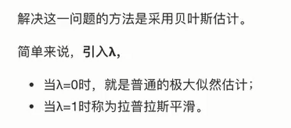朴素贝叶斯简介(概率分类)

概率基础



联合概率、条件概率与相互独立

贝叶斯公式
介绍




案例


API

商品评论情感分析

导入依赖
import pandas as pd
import numpy as py
import jieba
import matplotlib.pyplot as plt
from sklearn.feature_extraction.text import CountVectorizer
from sklearn.naive_bayes import MultinomialNB
获取数据
data = pd.read_csv("evaluation.csv",encoding="gbk")
data

数据基本处理
# 取出内容列,用于后面分析
content = data["内容"]
content

# 把评价中的好评差评转换为数字
data.loc[data.loc[:,"评价"] == "好评","评论编号"] =1
data.loc[data.loc[:,"评价"] == "差评","评论编号"] =0
data

# 选择停用词
stopwords = []
with open("stopwords.txt","r",encoding="utf-8") as f:
lines = f.readlines()
for tmp in lines:
line = tmp.strip()
stopwords.append(line)
stopwords = list(set(stopwords))
print("停用词:\n",stopwords)

# 把内容转换为标准格式
comment_list = []
for tmp in content:
# 把话切割成词
seg_list = jieba.cut(tmp,cut_all=False)
seg_str = ",".join(seg_list)
comment_list.append(seg_str)
comment_list

# 统计词个数
con = CountVectorizer(stop_words=stopwords)
X = con.fit_transform(comment_list)
X.toarray()

## 准备训练集和测试集
x_train = X.toarray()[:10,:]
y_train = data["评价"][:10]
print("训练集:\n",x_train)
print("训练集:\n",y_train)

x_test = X.toarray()[10:,:]
y_test = data["评价"][10:]
print("测试集:\n",x_test)
print("测试集:\n",y_test)

模型训练
mb = MultinomialNB(alpha=1)
mb.fit(x_train,y_train)
y_pre = mb.predict(x_test)
模型评估
print("预测值",y_pre)
print("真实值",y_test)

mb.score(x_test,y_test)

朴素贝叶斯优缺点

朴素贝叶斯内容汇总
NB的原理

朴素贝叶斯朴素在哪

为什么引入条件独立性假设

在估计条件概率P(X|Y)时出现概率为0的情况怎么办

为什么属性独立性假设在实际情况中很难成立,但朴素贝叶斯任能取得较好的效果

朴素贝叶斯与LR(逻辑回归)的区别

